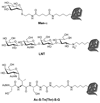An array-based method to identify multivalent inhibitors
- PMID: 20583754
- PMCID: PMC2923827
- DOI: 10.1021/ja100608w
An array-based method to identify multivalent inhibitors
Abstract
Carbohydrate-protein interactions play a critical role in a variety of biological processes, and agonists/antagonists of these interactions are useful as biological probes and therapeutic agents. Most carbohydrate-binding proteins achieve tight binding through formation of a multivalent complex. Therefore, both ligand structure and presentation contribute to recognition. Since there are many potential combinations of structure, spacing, and orientation to consider and the optimal one cannot be predicted, high-throughput approaches for analyzing carbohydrate-protein interactions and designing inhibitors are appealing. In this report, we develop a strategy to vary neoglycoprotein density on a surface of a glycan array. This feature of presentation was combined with variations in glycan structure and glycan density to produce an array with approximately 600 combinations of glycan structure and presentation. The unique array platform allows one to distinguish between different types of multivalent complexes on the array surface. To illustrate the advantages of this format, it was used to rapidly identify multivalent probes for various lectins. The new array was first tested with several plant lectins, including concanavalin A (conA), Vicia villosa isolectin B4 (VVL-B(4)), and Ricinus communis agglutinin (RCA120). Next, it was used to rapidly identify potent multivalent inhibitors of Pseudomonas aeruginosa lectin I (PA-IL), a key protein involved in opportunistic infections of P. aeruginosa , and mouse macrophage galactose-type lectin (mMGL-2), a protein expressed on antigen presenting cells that may be useful as a vaccine targeting receptor. An advantage of the approach is that structural information about the lectin/receptor is not required to obtain a multivalent inhibitor/probe.
Figures




Similar articles
-
Glycan-Gold Nanoparticles as Multifunctional Probes for Multivalent Lectin-Carbohydrate Binding: Implications for Blocking Virus Infection and Nanoparticle Assembly.J Am Chem Soc. 2020 Oct 21;142(42):18022-18034. doi: 10.1021/jacs.0c06793. Epub 2020 Sep 29. J Am Chem Soc. 2020. PMID: 32935985
-
Multivalent gold glycoclusters: high affinity molecular recognition by bacterial lectin PA-IL.Chemistry. 2012 Apr 2;18(14):4264-73. doi: 10.1002/chem.201102034. Epub 2012 Feb 23. Chemistry. 2012. PMID: 22362615
-
Catanionic Vesicles as a Facile Scaffold to Display Natural N-Glycan Ligands for Probing Multivalent Carbohydrate-Lectin Interactions.Bioconjug Chem. 2023 Feb 15;34(2):392-404. doi: 10.1021/acs.bioconjchem.2c00560. Epub 2023 Jan 15. Bioconjug Chem. 2023. PMID: 36642983 Free PMC article.
-
Bridging lectin binding sites by multivalent carbohydrates.Chem Soc Rev. 2013 May 21;42(10):4492-503. doi: 10.1039/c3cs60089k. Epub 2013 Apr 19. Chem Soc Rev. 2013. PMID: 23598793 Review.
-
Differential binding properties of Gal/GalNAc specific lectins available for characterization of glycoreceptors.Indian J Biochem Biophys. 1997 Feb-Apr;34(1-2):61-71. Indian J Biochem Biophys. 1997. PMID: 9343930 Review.
Cited by
-
Chemistry of natural glycan microarrays.Curr Opin Chem Biol. 2014 Feb;18:70-7. doi: 10.1016/j.cbpa.2014.01.001. Epub 2014 Jan 30. Curr Opin Chem Biol. 2014. PMID: 24487062 Free PMC article. Review.
-
Human oral lectin ZG16B acts as a cell wall polysaccharide probe to decode host-microbe interactions with oral commensals.Proc Natl Acad Sci U S A. 2023 May 30;120(22):e2216304120. doi: 10.1073/pnas.2216304120. Epub 2023 May 22. Proc Natl Acad Sci U S A. 2023. PMID: 37216558 Free PMC article.
-
Enhanced Binding and Reduced Immunogenicity of Glycoconjugates Prepared via Solid-State Photoactivation of Aliphatic Diazirine Carbohydrates.Bioconjug Chem. 2021 Jan 20;32(1):133-142. doi: 10.1021/acs.bioconjchem.0c00555. Epub 2020 Dec 16. Bioconjug Chem. 2021. PMID: 33325683 Free PMC article.
-
Surface Modification with Control over Ligand Density for the Study of Multivalent Biological Systems.ChemistryOpen. 2020 Jan 8;9(1):53-66. doi: 10.1002/open.201900290. eCollection 2020 Jan. ChemistryOpen. 2020. PMID: 31921546 Free PMC article. Review.
-
Synthetic glycoscapes: addressing the structural and functional complexity of the glycocalyx.Interface Focus. 2019 Apr 6;9(2):20180080. doi: 10.1098/rsfs.2018.0080. Epub 2019 Feb 15. Interface Focus. 2019. PMID: 30842878 Free PMC article. Review.
References
Publication types
MeSH terms
Substances
Grants and funding
LinkOut - more resources
Full Text Sources
Other Literature Sources

